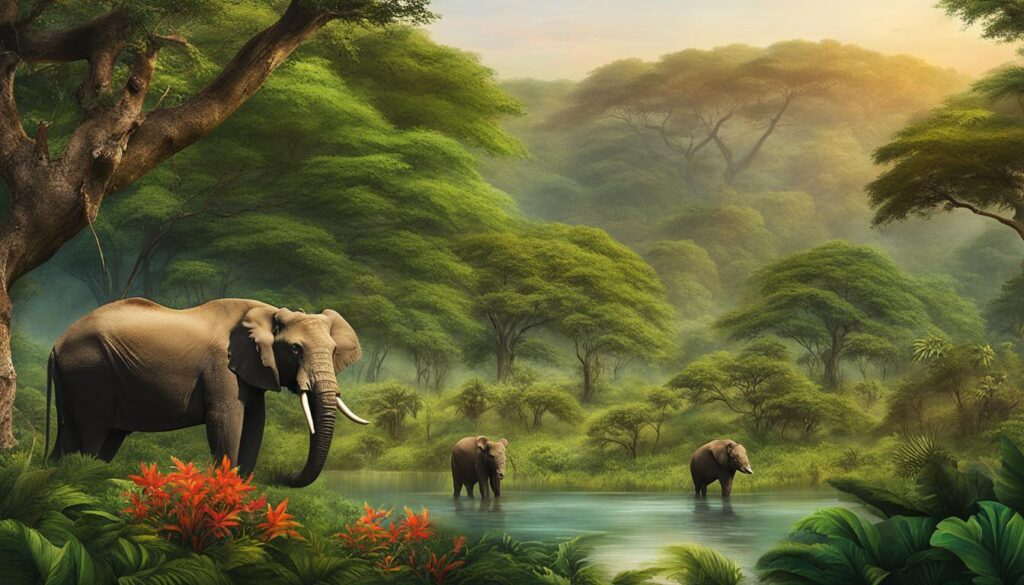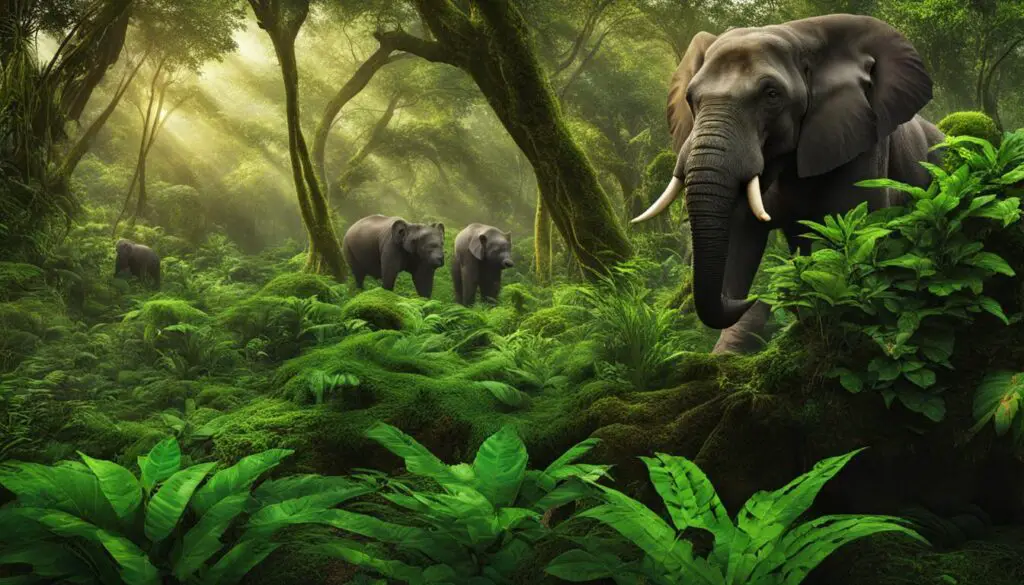The Central African Republic (CAR) is a country rich in wildlife and biodiversity. Located in the heart of Africa, CAR is home to a diverse range of animal species and habitats. From rainforests to savannas, CAR offers a unique environment that supports a wide array of wildlife.
Despite the abundance of wildlife, the animals in CAR face various challenges, including poaching, habitat loss, and the illegal wildlife trade. To protect these magnificent creatures and preserve the country’s natural heritage, CAR has implemented robust wildlife conservation efforts.

- The Central African Republic is known for its rich wildlife and biodiversity.
- Poaching, habitat loss, and illegal wildlife trade are major challenges for animal conservation in CAR.
- CAR has implemented strong measures to protect wildlife and preserve its natural heritage.
- Visitors to CAR can experience unique wildlife encounters in its national parks and reserves.
- Supporting wildlife conservation initiatives in CAR helps ensure the long-term survival of endangered species.
Wildlife Habitats in Central African Republic
The Central African Republic (CAR) is renowned for its diverse wildlife habitats, encompassing expansive rainforests, sprawling savannas, and pristine grasslands. The country’s geography can be categorized into three distinct regions: the Western Congo Basin Forests, the Northeastern Congo Basin Forests, and the Sudanian Savannas.
In the lush rainforests of the CAR’s southern regions, an array of iconic animal species thrives. Among them are majestic elephants, intelligent chimpanzees, formidable crocodiles, graceful hippos, and elegant giraffes. These rich and biodiverse rainforests serve as vital ecosystems for countless flora and fauna, providing shelter, sustenance, and protection.
In the central part of the country, vast savannas dominate the landscape. These savannas present a unique environment that supports a diverse range of wildlife, distinct from that found in the rainforests. Here, visitors can encounter various species adapted to this open grassland habitat, including antelopes, zebras, cheetahs, and ostriches.
In the northernmost regions of the Central African Republic, expansive grasslands thrive, offering peculiar ecological niches for different plant and animal species. The wildlife in these grasslands has adapted to survive in arid conditions, showcasing fascinating biological resilience.
The distinctiveness and variety of these wildlife habitats contribute to the Central African Republic’s exceptional biodiversity. From verdant rainforests to expansive savannas and unique grasslands, the CAR’s diverse landscapes serve as critical breeding grounds, corridors, and homes for an abundance of animal species.
National Parks and Reserves in Central African Republic
The Central African Republic (CAR) has taken significant measures to protect its natural heritage by establishing a network of national parks, nature reserves, and protected areas. These conservation zones play a crucial role in preserving the country’s unique biodiversity and providing a safe habitat for the diverse range of flora and fauna found in the CAR.
Among the most renowned national parks in the Central African Republic are:
- Manovo-Gounda St. Floris National Park: This park is home to a high concentration of hippos and showcases the stunning beauty of the CAR’s natural landscape.
- Bamingui-Bangoran National Park: Located in the north, this national park offers visitors a chance to explore the diverse ecosystems and witness an array of wildlife species.
- Dzanga-Sangha Reserve: Covered in lush rainforests, this reserve is a haven for wildlife, including gorillas, elephants, and an assortment of bird species.
In addition to these national parks, the Central African Republic boasts a multitude of other protected areas, such as presidential parks, wildlife reserves, and biosphere reserves. These zones provide additional protection for the environment and its inhabitants, ensuring the long-term conservation of the CAR’s natural resources.
The establishment of national parks and reserves not only contributes to wildlife conservation efforts but also promotes sustainable tourism in the Central African Republic. The diverse range of ecosystems and abundant wildlife attract nature enthusiasts and adventure seekers from around the world, offering them a unique opportunity to experience the beauty and wonders of the CAR’s natural landscapes.

Visiting these protected areas provides a chance to appreciate the country’s rich biodiversity while supporting the local communities involved in wildlife conservation and eco-tourism initiatives. By exploring the national parks and reserves in the Central African Republic, visitors contribute to the preservation of this valuable natural heritage and ensure a sustainable future for the CAR’s wildlife and ecosystems.
Endangered Species in Central African Republic
The Central African Republic is home to several endangered species that require special attention and conservation efforts. Some of these species include the African forest elephant, western lowland gorilla, red colobus monkey, and Lord Derby’s scaly-tailed squirrel. These animals face threats such as habitat loss, poaching, and illegal wildlife trade.
To protect these species, the CAR government and conservation organizations are implementing various strategies:
- Anti-poaching patrols
- Community-based conservation initiatives
- Public-private partnerships
These efforts aim to ensure the long-term survival of these endangered species and maintain the country’s biodiversity.

“Conservation is the key to preserving the incredible diversity of wildlife found in the Central African Republic. Through collaborative efforts, we can protect these endangered species and their habitats for future generations.”
Wildlife Conservation in Central African Republic
Wildlife conservation plays a crucial role in the Central African Republic (CAR). The CAR government, along with various conservation organizations, is dedicated to protecting wildlife habitats, preventing poaching, and promoting the sustainable use of natural resources to preserve the rich biodiversity of the region.
One notable organization actively involved in wildlife conservation in the CAR is African Parks. They play a significant role in managing protected areas, including the renowned Chinko Nature Reserve. Through their conservation efforts, they safeguard vital habitats and protect endangered species, contributing to the long-term survival of wildlife in the CAR.
The CAR government has also enacted laws and regulations that prioritize wildlife protection. These laws establish protected areas, highlighting the government’s commitment to preserving the natural heritage of the country. By designating these areas, the government ensures the conservation of important habitats and ecosystems.
Furthermore, wildlife conservation efforts in the CAR extend beyond protecting animals. They also aim to benefit local communities by promoting sustainable livelihoods and eco-tourism opportunities. These initiatives create a harmonious balance between conservation and the well-being of the local population.
Central African Republic wildlife conservation, conservation organizations in Central African Republic, and wildlife protection in Central African Republic are crucial elements in preserving the diverse and unique natural heritage of the country.
Wildlife Tourism in Central African Republic
The Central African Republic (CAR) is a hidden gem for wildlife enthusiasts, offering unforgettable experiences in its diverse natural habitats. From national parks and reserves to breathtaking landscapes, the CAR has something for every wildlife lover. By participating in wildlife tourism, visitors can not only witness the beauty of nature but also contribute to the conservation efforts in the country.
One of the most popular activities for tourists visiting the CAR is embarking on thrilling wildlife safaris. These safaris provide the opportunity to spot a wide range of animals, including elephants, lions, leopards, and buffalo. With experienced guides leading the way, visitors can get up close and personal with these magnificent creatures while learning about their behaviors and habitats.
Birdwatching is another favorite pastime in the CAR, home to over 663 species of birds. From colorful parrots to rare raptors, the country offers endless possibilities for bird enthusiasts. The diverse ecosystems provide a haven for both migratory and endemic species, making it a paradise for birdwatchers.
A highlight of wildlife tourism in the CAR is gorilla tracking. The country is home to the Western Lowland Gorilla, one of the most endangered primates in the world. Tracking these gentle giants in their natural habitat is a once-in-a-lifetime experience that allows visitors to observe their social interactions and witness their incredible strength and intelligence.
Eco-tourism initiatives have been developed in the CAR to ensure that tourism activities are sustainable and beneficial for local communities. These initiatives aim to support the conservation efforts in the country while providing economic opportunities for the local population. By participating in eco-tourism activities, visitors can directly contribute to the protection of the Central African Republic’s natural heritage.
Whether it’s exploring the sprawling savannas or venturing into the dense rainforests, wildlife tourism in the Central African Republic promises an immersive experience that will leave a lasting impression. By promoting conservation, raising awareness, and supporting local communities, visitors can play a vital role in safeguarding the precious wildlife habitats of the CAR for generations to come.
Conclusion
The Central African Republic is a biodiverse paradise, housing a remarkable range of animal species amidst its varied habitats. However, these precious creatures face numerous challenges, including relentless poaching, habitat destruction, and the illegal wildlife trade. To safeguard these unique animals and their habitats, the government of the Central African Republic, in collaboration with dedicated conservation organizations, has established national parks, reserves, and protected areas. These vital initiatives are aimed at ensuring the long-term survival of endangered species, preserving biodiversity, and promoting the responsible and sustainable utilization of natural resources.
Significantly, wildlife tourism has emerged as a key player in supporting conservation efforts while generating economic avenues for local communities. By visiting the Central African Republic and actively supporting wildlife conservation initiatives, tourists have the power to contribute directly to the preservation of this invaluable natural heritage. Moreover, they can revel in extraordinary wildlife encounters, whether it’s venturing on captivating wildlife safaris, engaging in mesmerizing birdwatching experiences, or embarking on exhilarating gorilla tracking expeditions.
The triumph of wildlife conservation in the Central African Republic lies not only in the proactive measures established by the government but also in the commitment and unwavering efforts of the local communities, NGOs, and environmentalists who tirelessly work together to protect this vulnerable ecosystem. By nurturing and sustaining these crucial partnerships, the Central African Republic can continue to safeguard its remarkable wildlife and uphold its status as a haven for biodiversity in the heart of Africa.
FAQ
What kind of wildlife can be found in the Central African Republic?
The Central African Republic is home to a diverse range of wildlife, including elephants, chimpanzees, crocodiles, hippos, giraffes, and a variety of bird, mammal, reptile, and amphibian species.
Are there any protected areas in the Central African Republic?
Yes, the Central African Republic has established national parks, nature reserves, and protected areas to safeguard its rich natural heritage, including the Manovo-Gounda St. Floris National Park, Bamingui-Bangoran National Park, and Dzanga-Sangha Reserve.
What are the major threats to wildlife in the Central African Republic?
The wildlife in the Central African Republic faces threats such as ivory poaching, bushmeat exploitation, habitat loss, and illegal wildlife trade.
What is being done to protect endangered species in the Central African Republic?
The government of the Central African Republic, along with conservation organizations, is implementing strategies such as anti-poaching patrols, community-based conservation initiatives, and public-private partnerships to protect endangered species and their habitats.
How does wildlife conservation benefit local communities in the Central African Republic?
Wildlife conservation efforts in the Central African Republic aim to promote sustainable livelihoods and eco-tourism opportunities for local communities, contributing to their economic development while preserving the country’s natural heritage.
What kind of wildlife tourism opportunities are available in the Central African Republic?
Visitors to the Central African Republic can enjoy wildlife safaris, birdwatching, and gorilla tracking in national parks, reserves, and natural habitats that are home to a diverse range of flora and fauna.
